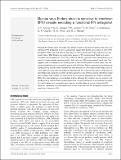Files in this item
Mumps virus Enders strain is sensitive to interferon (IFN) despite encoding a functional IFN antagonist
Item metadata
| dc.contributor.author | Young, D F | |
| dc.contributor.author | Galiano, M | |
| dc.contributor.author | Lemon, K | |
| dc.contributor.author | Chen, Y-H | |
| dc.contributor.author | Andrejeva, Jelena | |
| dc.contributor.author | Duprex, P | |
| dc.contributor.author | Rima, B K | |
| dc.contributor.author | Randall, Richard Edward | |
| dc.date.accessioned | 2010-12-21T10:06:03Z | |
| dc.date.available | 2010-12-21T10:06:03Z | |
| dc.date.issued | 2009-11 | |
| dc.identifier | 455045 | |
| dc.identifier | b5364ad2-ee97-49a7-9488-961ef5da3248 | |
| dc.identifier | 000271440500019 | |
| dc.identifier | 70350443463 | |
| dc.identifier.citation | Young , D F , Galiano , M , Lemon , K , Chen , Y-H , Andrejeva , J , Duprex , P , Rima , B K & Randall , R E 2009 , ' Mumps virus Enders strain is sensitive to interferon (IFN) despite encoding a functional IFN antagonist ' , Journal of General Virology , vol. 90 , no. 11 , pp. 2731-2738 . https://doi.org/10.1099/vir.0.013722-0 | en |
| dc.identifier.issn | 0022-1317 | |
| dc.identifier.other | ORCID: /0000-0002-9304-6678/work/60426972 | |
| dc.identifier.uri | https://hdl.handle.net/10023/1640 | |
| dc.description.abstract | Although the Enders strain of mumps virus (MuV) encodes a functional V protein that acts as an interferon (IFN) antagonist, in multi-cycle growth assays MuV Enders grew poorly in naive ('IFN-competent' Hep2) cells but grew to high titres in 'IFN-compromised' Hep2 cells. Even so, the growth rate of MuV Enders was significantly slower in 'IFN-compromised' Hep2 cells when compared with its replication rate in Vero cells and with the replication rate of parainfluenza virus type 5 (a closely related paramyxovirus) in both naive and 'IFN-compromised' Hep2 cells. This suggests that a consequence of slower growth is that the IFN system of naive Hep2 cells can respond quickly enough to control the growth of MuV Enders. This is supported by the finding that rapidly growing variants of MuV Enders that were selected on 'IFN-compromised' Hep2 cells (i.e. in the absence of any selection pressure exerted by the IFN response) also grew to high titres on naive Hep2 cells. Sequencing of the complete genome of one of these variants identified a single point mutation that resulted in a substitution of a conserved asparagine by histidine at position 498 of the haemagglutinin-neuraminidase protein, although this mutation was not present in all rapidly growing variants. These results support the concept that there is a race between the ability of a cell to detect and respond to virus infection and the ability of a virus to block the IFN response. Importantly, this emphasizes that factors other than viral IFN antagonists influence the sensitivity of viruses to IFN. | |
| dc.format.extent | 8 | |
| dc.format.extent | 387662 | |
| dc.language.iso | eng | |
| dc.relation.ispartof | Journal of General Virology | en |
| dc.subject | Dependent rna-polymerase | en |
| dc.subject | V-protein | en |
| dc.subject | Antiviral responses | en |
| dc.subject | RIG-I | en |
| dc.subject | Parainfluenza virus-5 | en |
| dc.subject | Gene-expression | en |
| dc.subject | Degredation | en |
| dc.subject | Induction | en |
| dc.subject | Cells | en |
| dc.subject | Transduction | en |
| dc.subject | QR355 Virology | en |
| dc.subject.lcc | QR355 | en |
| dc.title | Mumps virus Enders strain is sensitive to interferon (IFN) despite encoding a functional IFN antagonist | en |
| dc.type | Journal article | en |
| dc.contributor.institution | University of St Andrews. School of Biology | en |
| dc.contributor.institution | University of St Andrews. Biomedical Sciences Research Complex | en |
| dc.identifier.doi | https://doi.org/10.1099/vir.0.013722-0 | |
| dc.description.status | Peer reviewed | en |
| dc.identifier.url | http://www.scopus.com/inward/record.url?scp=70350443463&partnerID=8YFLogxK | en |
This item appears in the following Collection(s)
Items in the St Andrews Research Repository are protected by copyright, with all rights reserved, unless otherwise indicated.

